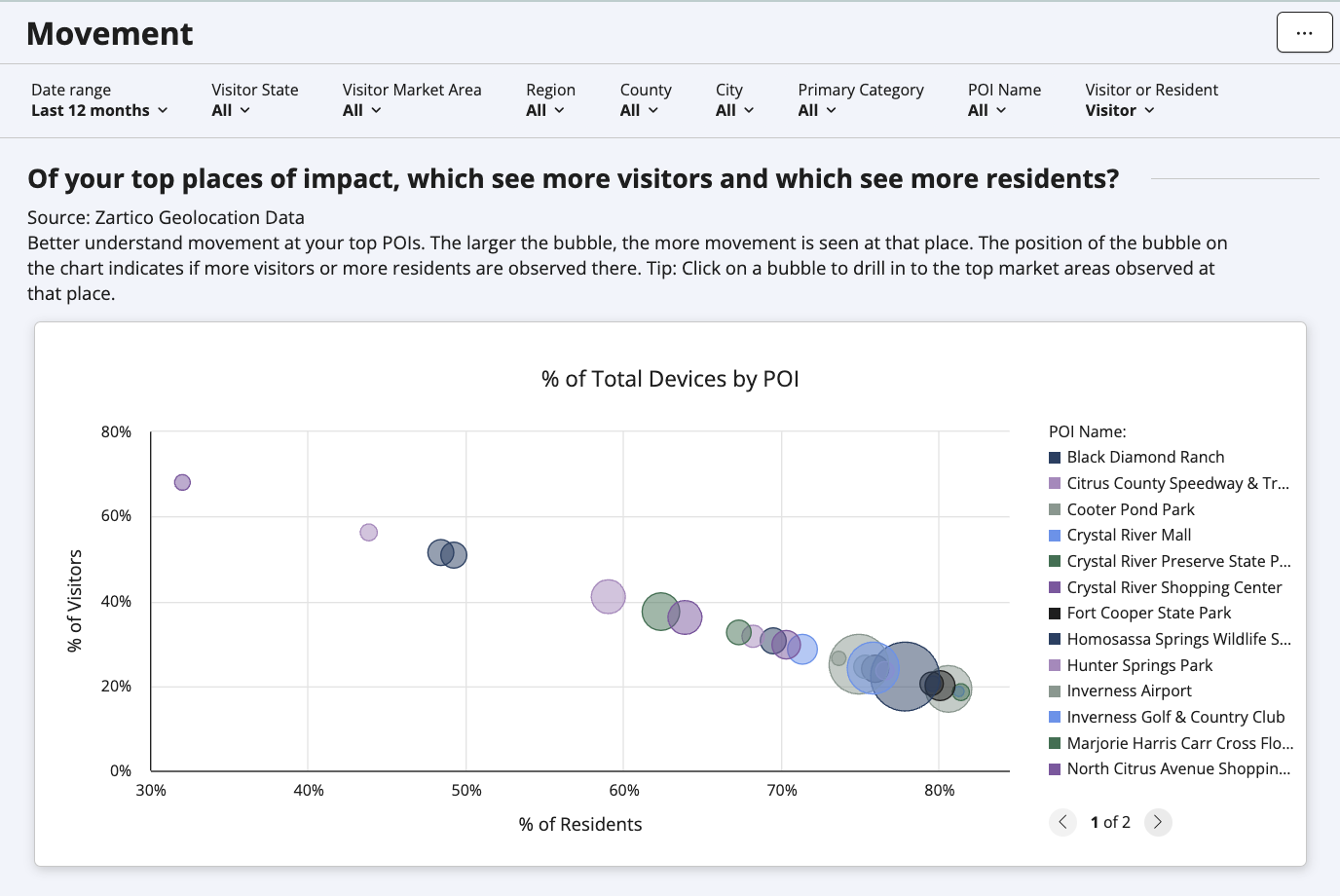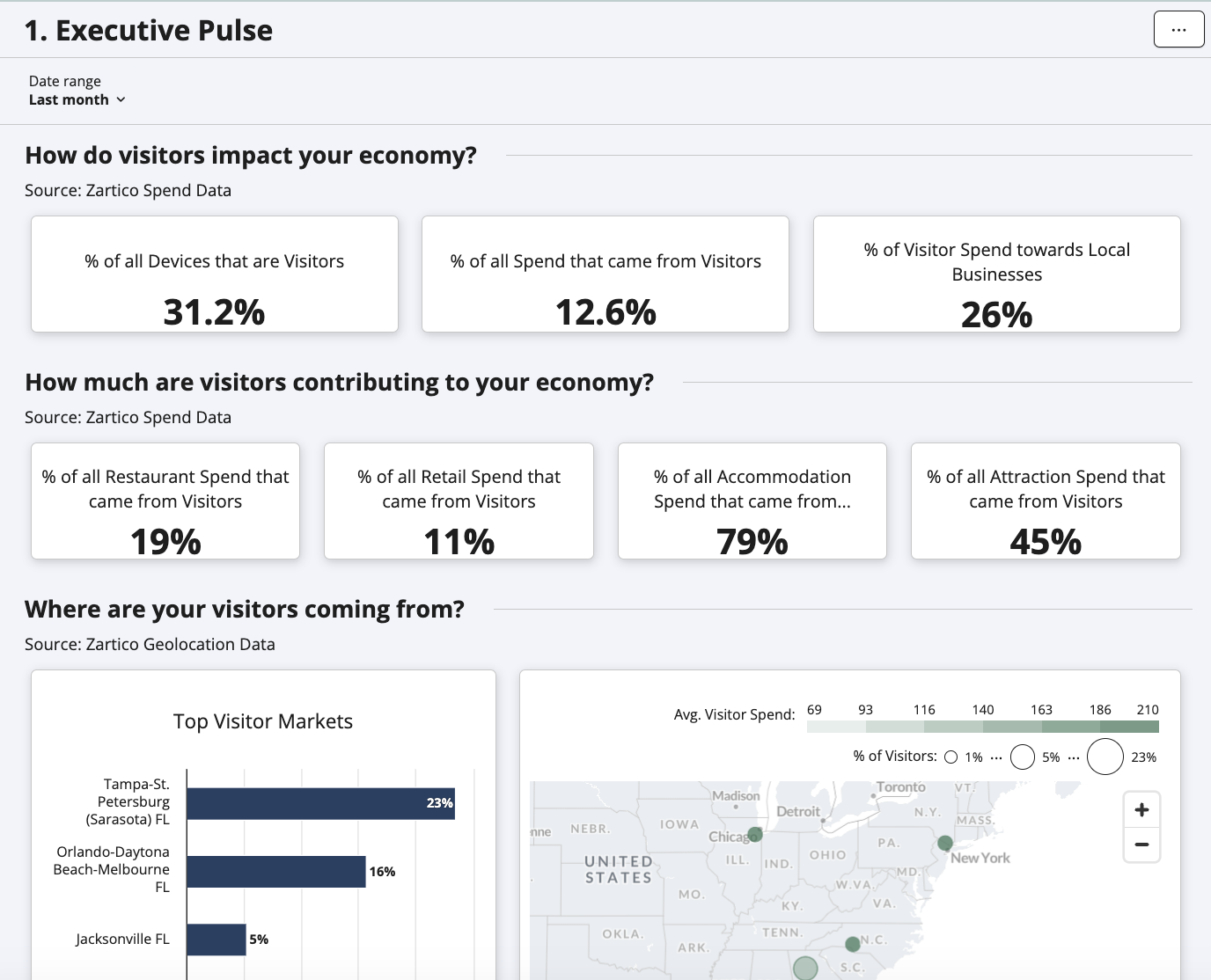Building Trust With Data: Crystal River Transforms Stakeholder Relationships
When Auvis Cole stepped into his role at Discover Crystal River in February 2024, he saw clear opportunities to make a big impact as the destination’s new leader: improve community stakeholder relationships, refine the strategic direction, and enhance efficiencies with the organization’s budget. Auvis believed that building a data-driven foundation for the destination marketing organization would be the best way to gain buy-in for these initiatives and set the organization on the right path for future success.
Here's how Auvis and his team leveraged the Zartico Destination Operating System® (ZDOS®) to uncover strategic insights and strengthen relationships with key stakeholders.
The Challenge
At the beginning of his tenure, Auvis identified a few primary opportunities:
- It had been several years since the destination engaged in meaningful strategic planning with stakeholders, and they were missing a community compass to guide the organization’s marketing decisions.
- There was no universal data source that connected the dots between research reports, campaign analytics, and the metrics they reported to community stakeholders.
- A broad lack of understanding about tourism’s impact, including concerns about overtourism, had eroded community relationships among residents and local industry partners
“When I came into the marketplace,” Auvis says, “I wanted to be a more data-driven organization because no matter who you are or what community you're in, people can, for the most part, respect the number — or if not a number, a behavioral insight behind a number.”

Courtesy of Discover Crystal River
The Strategy
Relying on destination marketing data would, as Auvis says, apply “more of a systemic approach to an intangible product, allowing folks to understand our value.”
The team embarked on an initiative to weave data and stakeholder education together, launching monthly forums called Partners in Tourism (PIT). In the beginning, the PIT events offered an opportunity to reintroduce Discover Crystal River to industry partners, share a high-level marketing plan, and engage partners in a conversation about how that marketing plan aligns with their goals.
The meetings have been a highly sustainable model for connecting partners across the county. Auvis invites guest presenters and dedicates time for each attendee to introduce themselves and share a few words.
“What makes it really cool is it became really organic,” Auvis says. “Now we have 50 to 60+ partners attending these meetings on a monthly basis, and they are building reciprocal relationships with one another that they have never before been a part of.”
💡 Bright idea: Auvis and the team apply a “L.E.A.D.” framework to these partner initiatives:
- Leverage: Introduce the destination organization to tourism stakeholders
- Educate: Share goals and strategy, using data as a grounding tool for everyone involved
- Advocate: Present trends and opportunities
- Develop: Create new business opportunities
Leveraging Zartico's Platform
Data insights from Zartico play a central role in Crystal River’s stakeholder and community engagement efforts. By sharing metrics and KPIs, Auvis can show partners how to better partner with the organization, as well as how to uplevel their own marketing by better understanding who their customers are and what they want.
In addition to high-level insights shared at the monthly PIT meetings, there are two ZDOS® modules that have been especially influential in stakeholder conversations.
Movement Module

Granular movement data addresses overtourism concerns and busts misconceptions, especially when the team can demonstrate the balance between visitor and resident activity:
- Analyzed visitor patterns at key points of interest
- Demonstrated actual visitor vs. resident ratios at popular locations
- Used data visualizations to show real impact versus perception
💡 Bright idea: Interacting with the live data, instead of a static chart, can open new pathways for the audience to understand the insights in their own context, as Auvis discovered in one meeting:
“I chose a restaurant from among our top points of interest and asked the group what proportion of residents and visitors are observed there,” Auvis says. “They guessed 85% resident, 15% visitor, but when I moused over the chart it showed 60% resident, 40% visitor. To drive home the importance of the visitor economy, I pointed out, ‘If you took 40 cents off of that restaurateur’s dollar, I can tell you right now they wouldn't be in business.’”
Executive Pulse

Auvis developed a monthly reporting system for county commissioners and administrators:
- Provided data-driven talking points for elected officials
- Shared district-specific metrics and impacts
- Enabled informed responses to constituent concerns
“I use the Executive Pulse in the monthly summaries I give to the county administrator and my board of county commissioners,” Auvis says. “It gives them context so that when that person concerned about overtourism does call or email, they can respond from a place of greater understanding, with data points that speak to the dynamic between visitors and residents and what they contribute to the community.”
Results & Key Takeaways
These data-driven, partner-focused initiatives are shifting how Discover Crystal River operates and how tourism is perceived in the community.
By showcasing how the DMO leverages data to direct marketing decisions, they have inspired stakeholders to focus on their own marketing efforts with renewed energy and aligned the community around the DMO’s success. Nine local businesses have sought proposals from PR firms and marketing agencies, and one partner’s SEO push bumped their business from 50th to 8th place in search rankings.
Partners are actively investing in their own marketing efforts — which meaningfully amplifies the destination's message and compounds tourism's economic impact.
“Creating a team of more educated, business-savvy local industry partners is good for the DMO,” Auvis says. “Our CPM goes down, our [return on ad spend] goes up... because now I have all these ambassadors playing a role. If everybody's doing a little bit of marketing, it has an amplifying effect and becomes easier to show off the experience that visitors can expect here.”

Key takeaways for destination marketers
- Lead with data to build stakeholder trust: Data breaks down misconceptions, establishes a common starting point, and offers valuable information the audience can apply to their own decision-making.
- Present both county-wide and community-specific metrics: Tourism impact can be highly nuanced and vary greatly within a destination’s boundary. Provide targeted and big-picture insights for maximum situational awareness.
- Create regular forums for partner interaction and education: It’s a win-win for communicating your message and facilitating community relationships.
- Equip leaders with data-driven talking points: Give elected officials and community business leaders the tools to become advocates for tourism.
- Demonstrate the interplay between visitor and resident impact: Both groups are integral to a thriving community.
By employing a data-driven approach and sharing Zartico’s data insights, Discover Crystal River has transformed apathy into advocacy, creating a collaborative ecosystem where tourism's value is understood and embraced by all stakeholders.
Data opens doors. Here are our top recommendations for data points to share with stakeholders to invite powerful community conversations.



